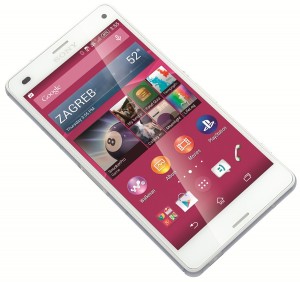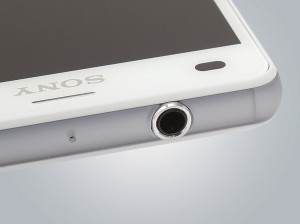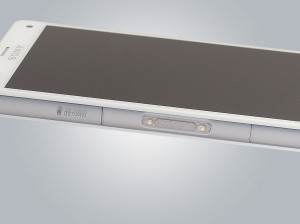In most cases, whenever a smartphone manufacturer re-imagines its flagship for a more compact size, it also diminishes that smaller phone’s hardware and abilities. Sony has become one of the few exceptions to this unfortunate trend, shrinking its Xperia series without punishing those who dare to prefer a phone under five inches in the process.
And so Sony has launched the Xperia Z3 Compact, the latest of these ”compact flagships,” with its 4.6-inch display, Qualcomm’s quad-core Snapdragon 801 running a 2.5 GHz clock, 20.7-megapixel camera, glass waterproof body, and UI based on Android 4.4.4. For all intents and purposes, its size is the only significant difference between it and the 5.2-inch Xperia Z3. That is a good, and, sadly, still unique thing.
Nevertheless, the Xperia Z3 Compact follows up on the groundwork laid by its predecessor, the Xperia Z1 Compact. Sony has gone through flagships at a blistering pace since that device was revealed at CES this past January – so much so that the Xperia Z2 didn’t even get a “Compact” equivalent – but the improvements made in that time have been significant, even if there is still room for improvement. Let’s dive deeper into the Xperia Z3 Compact, which is available now for $530 unlocked.
Build and Design
When it comes to design and materials, the Xperia Z3 Compact represents important progress from the Xperia Z1 Compact. Despite a comparatively larger screen (4.6 inches compared to 4.3 inches), it’s slimmer, lighter, and still features a bigger battery. More importantly, the front and back of the device are both coated in smooth glass, whereas the older phone had a lesser-quality plastic back.
Unlike the bigger Xperia Z3, the Compact’s sides are slightly rounded, and made of a solid silicone type of plastic instead of metal. While the change detracts from the rest of the phone’s premium feel, it definitely makes the device more resistant to damage from potential falls and scuffs. That’s not to mention of the fact that the whole thing is still heavily water- and dust-resistant.
Indeed, the Z3 Compact is an ergonomic little handset that’s quite reliable in most situations. It lies quite securely in hand, mostly due to its well-suited mass (129 grams) to dimensions (127 x 65 x 8.6 mm) ratio. It’s svelte and attractive in a manner reminiscent of the iPhone 4/4S, only with a larger, more contemporary size, similar to that of the iPhone 6. It’s got the same aesthetic we’ve come to expect from the Xperia line, but we’d definitely consider it an eye-catcher all the same.
The buttons of the Xperia Z3 Compact are laid out exactly as they are on the Xperia Z3. The sensors are on the front, along with an LED notification light, a speaker, and a 2.2-megapixel camera. Sony’s usual capacitive control keys are on the bottom of the screen, but they continue to waste display space, something that is already at a premium on a smaller device.
The back only includes the 20.7-megapixel camera lens and a LED flash. It cannot be opened, unfortunately, so the battery can’t be swapped out. The upper side includes a waterproof 3.5-mm audio jack and the secondary microphone, while the lower side includes the primary microphone.
The left side has the microUSB and microSD ports under one cover with protective seals, while the nanoSIM card slot is situated under another. It also includes the car charger dock slot. The protective seals are IP68 certified, meaning they can be kept under five feet of fresh water for up to 30 minutes. The right side includes the volume control, Power button, and camera button, in descending order.
Display
As previously mentioned, the Xperia Z3 Compact’s display has grown from 4.3 to 4.6 inches, but it has maintained the same resolution of 720 x 1280 pixels. This results in a lower pixel density of 319 ppi instead of the Xperia Z1 Compact’s 342 ppi. However, the sharpness here is still fine for ordinary use. Yes, flagship phones are expected to have Full HD resolutions these days, but individual pixels are difficult to spot with the naked eye at this point, outside of the odd animation. The display is still tinier than normal, so having a 720p resolution isn’t a notable problem in practice.
What’s more, most everything else about the Z3 Compact’s display is a step up from that of its predecessor. It uses “Live Color” LED technology, just like the larger Xperia Z3, as well as Sony’s proprietary “Triluminos” screen, which is said to combine red and green phosphorous with blue LEDS to achieve brighter and more harmonious colors without increasing power consumption.
In practice, most of those claims are valid. The tech also increased the display’s contrast ratio compared to the previous model, but it’s still far from perfect. Colors fade a bit when the screen when viewed from wider angles, but fortunately it isn’t severe enough to hinder everyday usage (a la the Samsung Galaxy Alpha). The screen is exceptionally bright and capable of producing vibrant, lively colors, which makes watching videos or browsing the web a highly pleasant experience.
The post Sony Xperia Z3 Compact Review: The Little Flagship appeared first on Brighthand.com.


